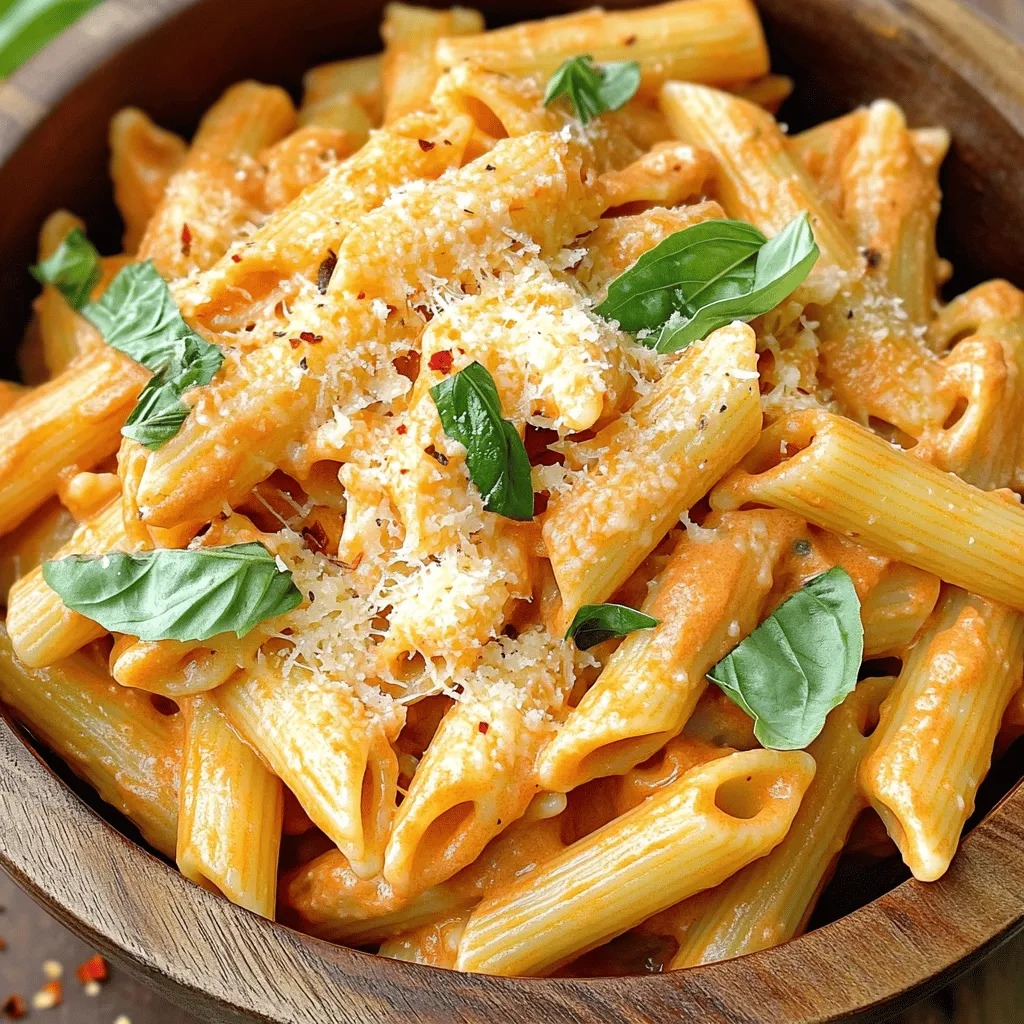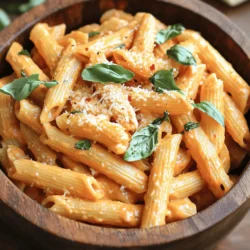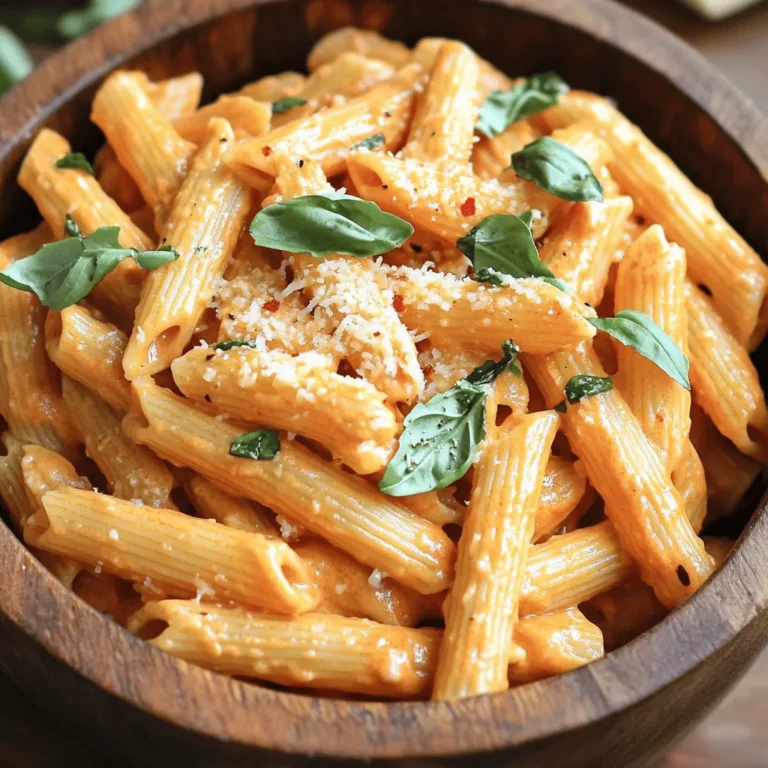Are you ready to whip up a simple yet delicious dish? My Creamy Tomato Basil Pasta is the perfect weeknight meal. With fresh ingredients and easy steps, you’ll impress yourself and your family. Whether you need a quick dinner or want to explore tasty variations, I’ve got you covered. Let’s dive into the joy of cooking and make a dish everyone will love!
Ingredients
Main Ingredients for Creamy Tomato Basil Pasta
To make a delicious creamy tomato basil pasta, you need the following main ingredients:
– 300g penne pasta
– 1 tablespoon olive oil
– 3 cloves garlic, minced
– 1 can (400g) crushed tomatoes
– 1 teaspoon dried oregano
– ½ teaspoon red pepper flakes (optional)
– 200ml heavy cream
– 100g grated Parmesan cheese
– Salt and freshly ground black pepper to taste
– 1 cup fresh basil leaves, chopped
– Extra grated Parmesan cheese for serving
These ingredients work together to create a rich and tasty dish. The penne pasta holds the sauce well, while the garlic adds aroma. Crushed tomatoes form the base of the sauce, and oregano gives it a nice herbal note. The heavy cream makes it smooth and rich, and Parmesan cheese adds depth.
Optional Ingredients for Added Flavor
Feel free to get creative! Here are some optional ingredients you can add:
– Cooked chicken or shrimp for protein
– Spinach or kale for extra greens
– A splash of balsamic vinegar for tanginess
– Mushrooms for an earthy flavor
Adding these ingredients can enhance your dish and make it more filling. Each option brings its unique taste, so you can mix and match based on your preferences.
Ingredient Substitutions
If you need to swap ingredients, here are some ideas:
– Use gluten-free pasta if avoiding gluten.
– Coconut cream can replace heavy cream for a dairy-free version.
– Use fresh tomatoes instead of canned for a fresh taste.
– Nutritional yeast can stand in for Parmesan cheese for a vegan option.
These substitutions keep the dish tasty while fitting different dietary needs. Always feel free to make it your own!
Step-by-Step Instructions
How to Cook the Pasta
To cook the pasta, start by boiling a large pot of salted water. Add 300g of penne pasta. Cook it according to the package instructions until it is al dente. This typically takes around 8 to 10 minutes. Once done, drain the pasta in a colander. Remember to save about a cup of the pasta water for later. Set the pasta aside while you prepare the sauce.
Sautéing Garlic and Building the Sauce
Now, let’s make the sauce. In a large skillet, heat 1 tablespoon of olive oil over medium heat. Once the oil is hot, add 3 cloves of minced garlic. Sauté the garlic for about 1 minute. Stir it often to avoid burning. You want the garlic to smell great but not turn brown. Next, pour in 1 can of crushed tomatoes. Add 1 teaspoon of dried oregano and ½ teaspoon of red pepper flakes if you like some spice. Stir well and let it simmer for 5 to 7 minutes. This lets all the flavors combine nicely.
Combining Pasta and Sauce
After the sauce has simmered, lower the heat. Slowly pour in 200ml of heavy cream while stirring. Let the sauce simmer for another 3 to 4 minutes until it thickens. Now, add the drained penne pasta to the skillet. If the sauce seems too thick, mix in some of the reserved pasta water until you like the texture. Stir in 100g of grated Parmesan cheese until it melts into the sauce. Taste the pasta and adjust the salt and black pepper as needed. Finally, gently fold in 1 cup of chopped fresh basil, saving a few leaves for garnish. Serve the pasta hot, topped with extra Parmesan and basil. Enjoy this creamy tomato basil pasta delight!
Tips & Tricks
Enhancing Flavors with Herbs and Spices
To boost flavors, fresh herbs work wonders. Basil adds a sweet, fresh taste. Oregano brings a warm, earthy note. You can also try thyme or parsley for variety. A pinch of red pepper flakes adds a nice kick, too. Remember, fresh herbs shine when added at the end. This keeps their bright flavor and color intact.
Cooking Perfectly Creamy Pasta
Cooking pasta well is key. Always use plenty of salted water. This helps flavor the noodles. Cook until al dente, so the pasta has a slight bite. Reserve some pasta water to adjust the sauce later. This starchy water helps the sauce cling to the pasta. Stir the pasta into the sauce gently but thoroughly for an even coat.
Common Mistakes to Avoid
Avoid overcooking the garlic. If it burns, your sauce will taste bitter. Don’t skip the reserved pasta water; it’s vital for creaminess. If the sauce is too thick, a splash of this water can help. Lastly, be careful with salt. Taste your dish before adding more, as the cheese will also add saltiness. Following these tips will help you create a delicious creamy tomato basil pasta every time.

Variations
Vegetarian and Vegan Options
If you want a vegetarian version, simply skip the Parmesan cheese. You can use nutritional yeast to add a cheesy flavor. For a vegan option, replace the heavy cream with coconut cream or cashew cream. These swaps keep the dish rich and creamy without dairy. You’ll still enjoy the lovely taste of the tomatoes and basil.
Gluten-Free Alternatives
To make this dish gluten-free, choose gluten-free penne pasta. Many brands offer options made from rice, corn, or lentils. Cook the pasta as directed on the package. The creamy sauce pairs well with these alternatives. You won’t miss the regular pasta at all!
Adding Proteins and Vegetables
Boost the nutrition by adding proteins like grilled chicken, shrimp, or chickpeas. For a veggie-packed meal, toss in spinach, zucchini, or bell peppers. You can add these during the last few minutes of cooking. It’s an easy way to make the dish heartier and more colorful. Explore these variations to fit your taste and dietary needs while enjoying this creamy tomato basil pasta delight!
Storage Info
How to Store Leftover Pasta
To store leftover creamy tomato basil pasta, first let it cool. Place it in an airtight container. You can store it in the fridge for up to three days. Make sure to keep it sealed well to avoid drying out.
Reheating Tips for Best Results
When you reheat the pasta, use a skillet for best results. Add a splash of water or cream to keep it moist. Heat over low to medium heat, stirring often. This helps bring back the creamy texture. Avoid using a microwave, as it can dry out the pasta.
Freezing Creamy Tomato Basil Pasta
You can freeze creamy tomato basil pasta too! Place the cooled pasta in freezer-safe containers. It can last up to three months in the freezer. When ready to eat, thaw it overnight in the fridge before reheating. For the best flavor, add fresh basil and cheese after reheating. Enjoy every bite, even if it’s from the freezer!
FAQs
What is the best type of pasta for this recipe?
For creamy tomato basil pasta, I recommend penne. Its tube shape holds the sauce well. Other good choices are fusilli or farfalle. They also trap sauce in their curls and folds. If you prefer a gluten-free option, try brown rice penne or chickpea pasta. Both can give great flavor and texture.
Can I make this recipe ahead of time?
Yes, you can make this dish ahead of time. Cook the pasta and sauce separately. This way, they stay fresh and tasty. Store them in airtight containers in the fridge for up to three days. When ready to eat, warm the sauce and mix in the pasta. Add a splash of reserved pasta water to bring back creaminess.
How do I make a dairy-free version of creamy tomato basil pasta?
To create a dairy-free version, swap heavy cream for coconut cream or cashew cream. Both add richness without dairy. Use nutritional yeast instead of Parmesan cheese for a cheesy flavor. Lastly, check that your pasta is dairy-free as well. Enjoy a delicious, creamy dish without dairy!
In this blog post, we explored the key ingredients for creamy tomato basil pasta. You learned how to cook and combine pasta with a flavorful sauce. We discussed tips to enhance your dish and avoid common mistakes. You also discovered variations for different diets and how to store leftovers.
Overall, with these strategies, you can create a delicious meal. Enjoy making this dish your own and impressing family and friends!


